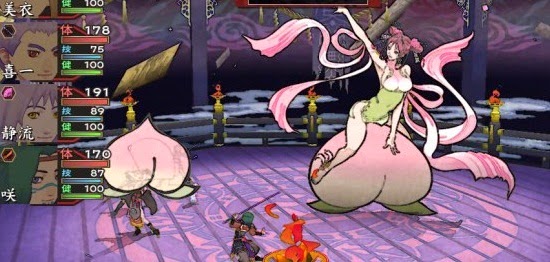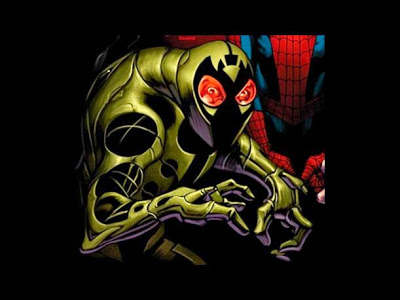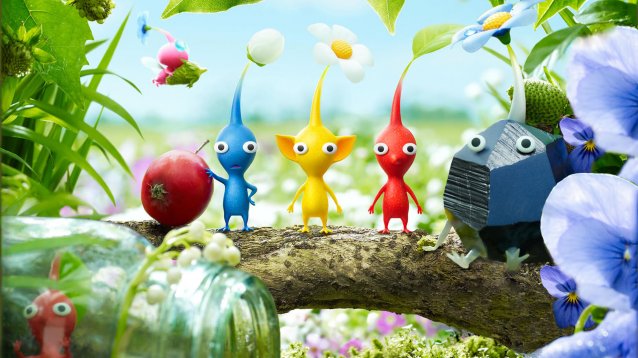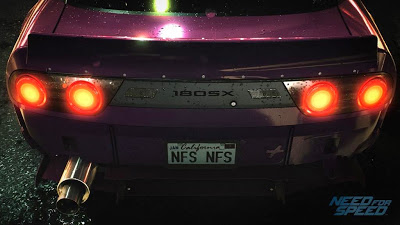

Oreshika: Tainted Bloodlines is the sequel to Ore no Shikabane o Koete Yuke, a Japanese cult RPG appeared in 1999 exclusively on PlayStation that despite obtaining a remarkable success never saw the light in the West. Powered by Alfa System, parents of the spin-off Tales of the World or the remarkable Phantasy Star Portable among others, the original title was distributed by SCEJ (Sony Computer Entertainment Japan) and then 'ported' to PSP in an adaptation that had as collateral better graphics, new dungeons and added side in different aspects of their mechanics. The proposed game is very similar to that of a generic dungeon crawler with a series of objectives to complete under specific requirements and a host of enemies to beat over a hundred hours of play, with one caveat: Oreshika. It is set in what the public usually called plain "feudal Japan," and as such is inspired by the Yamato-e style of the Muromachi era, so we talk about a game whose main attraction lies in its graphic presentation.
Tainted Bloodlines improves the highlights of its predecessor without losing the traits that made it a cult. The story puts us around, XIII, one hundred years after the events that took place in the original work, in the city of Kyoto, which undergoes a series of inclement after the disappearance of the five national treasures kept the Treasure House, near the Imperial Palace. This unleashes the wrath of the Gods, removing any trace of human life on the face of the Earth. The player takes the role of one of the members raised (by a curious ritual staged a scene anime video), which assumes the difficult task of returning to his clan lost splendor. Revenge, however, can not be executed within a period of time longer than two years, since the members of our clan are obsolete and die within two years to be back to life.
Creating lineage
In Oreshika our main goal is to challenge the Oni (demons) once every few months to consummate our revenge. To do so is essential to have fighters who handle various guilds and great physical strength, impossible to achieve within two years of life that each member of the clan consists task. The only way left is, therefore, ensure a line of fighters who possess the virtue that their parents have wrought in their short life. As "entities" resurrected, only clan members can "join" other damn characters or related to any of the elements making up the world Gods, so if our hero decides to join ties with a God of water, the result of the union will be a third member that is characterized by powerful attacks based on this element. The inherited skills and even the secret arts of each generation are passed to the next and so on until a pedigree of over 100 members, each with their specific strengths.
However, unite ties with God is an act that can only be done after specific elements that can only get in the exploration. Oreshika employs a navigation menu chaired by a sort of humanoid weasel who advises and guides during early in the game to overcome the apparent complexity of the gameplay. This is basically divided into three aspects: obtaining weapons, armor and all kinds of healing items, playback (with certain affinities and specificities) and learning skills, this last point closely related to exceed targets that are flagged before proceeding exploration of different scenarios which the world is made.
A helping hand
If we ask your support organization these experience points are automated, so only we will have to worry about taking action, participating in battle filled with enemies and finding scenarios. The idea is to gradually making decisions based on our level of experience. Since it is highly unlikely that we tested the original version, it is advisable to follow the directions of our constant companion to understand the parameters that follow when making specific decisions, such as how to use the money we get in the fighting or what characters you select to go scenarios. There are several difficult ways establishing the amount of experience points obtained in the fighting, rudeness of enemies, objects they emerge and even aggression when in contact with them, so all players should find a challenge for you.

Whatever our choice, sooner or later we will have to jump to the battlefield after choosing one of the scenarios we have at our disposal. The exploration represents the "playable" part of Oreshika. This is where we control a character who travels different scenarios, always alert to the presence of enemies roam and that should not surprise us to take the initiative. The early stages are very simple and basically force us to go from room to room by eliminating monsters to return with a specific loot, but as the hours pass go further setback such as locked doors, magic insurmountable barriers or enemies with high experience that force us (at best) to turn around to find an alternative path. Most importantly, however, is to ensure that our group of characters gets experience points to learn new skills to pass on to their descendants.
Turn-based combat
Find treasures can be important, but no doubt that the spark of the gameplay is in combat, on the other hand will look like Oreshika in which longer invest. Generally control a small group of fighters is faced with a fairly large group of enemies, always headed by a leader. Although get "beat" the combat and the group in question, get a lot of experience points depends on the speed and amount of enemies to be able to defeat a few hits. The difficulty of the combat system hardly varies with the difficulty level chosen, but the parameters to obtain them. At the start of each battle a roulette that rewards us with different prizes depending on what the selection, with an option to get magic scrolls, secrets or huge amounts of money if we have any luck object appears.
The outline of the fighting is governed by the maximum of strengths and weaknesses. A related water enemy to receive an electric shock while showing greater resistance to the wind, for example, one akin to fire, and so on. We can perform combo attacks a large number of enemies, melee attack or defend while limiting ourselves to observe the patterns that follow our enemies. Whatever our choice, more often listen to the recommendations that give us our own heroes as to attack this or that enemy. Doing so not only gives us a plus of experience points, but also higher affinity of the characters with our clan. There are more secondary aspects that come into play in combat, as the option to get points that give us the option of joining tie with more powerful gods or specialization of a strain on a specific class warrior, but are aspects that we find out our own and only broaden the spectrum of customization of the game.
Exploration Limited
More than the elements found in the fighting or personalization aspects in Oreshika time which governs much of the actions we take during the exploration. The events that take place in our race are governed by months. Whenever you set out to explore a dungeon rush days (indicated by a clock with different flames fade away while approaching next month): every battle, every conversation and virtually every step results in a useful life Short for our characters, or seen from another angle, in less remaining days to the birth of the next member of our lineage. This implies that most of the time, and once we have managed to acquire some level of expertise, the point is to achieve the goals we have set ourselves in the shortest amount of time. During the scan time can be accelerated in times of "frenzy" that allow us to deal with enemies or advance for stays faster, providing some variety to the monotonous exploration, which at times becomes really confusing and tedious.
There are a number of dungeons and many characters we want to make can be as large as we please, but there is little reason to level argument that push us to discover what awaits in the next month, which some of the main references of gender combined with excellent results, as in the case of Persona 3 / 4G. At a certain point there will be strange scenarios go at full speed, buying items almost by inertia and trying by all means to get enough points to join Gloria ties to a powerful God to get offspring provide the long-awaited revenge. However, this aspect allows us to play fast games without investing too much time in preparation, so it seems that Oreshika is the perfect place to enjoy a few games on the subway or bus to spend time entertaining complement.
Feudal Japan
The absence of a compelling argument also pushes us to consider this JRPG as a good opportunity to play a few quick games and move on. The story, like the graphics and technical generally based on some of the fees that usually attributed to the Japanese tradition. The characters move away from Shonen concept that populates most RPG adventures that have appeared in the catalog PSVita in recent months, which is quickly seen in the maturity of some conversations, all of which, incidentally, in English Original Japanese dubbing. However, the argument does not end taken seriously and becomes a mere decoration to continue exploring and fighting tirelessly to new monsters, so the opportunity to give some emphasis on the familial relationship between characters of our race. Actually, it does not seem that this has been the target of Alpha System, which is clearly focused on the gameplay as a workhorse.
Technically Oreshika shown as a solid JRPG that advocates using very colorful textures and scenarios drink of Japanese classical tradition, both in the character design and the selection of graphic imagery to give life to the environments we discovered along adventure. The sound aspect, whose main attraction is the almost ubiquitous in Japanese dub all the adventure, the game relies on gentle and very bearable melodies that gladden one ear while. Having to repeat again and again the same paths inevitably leads to tire quickly of the tunes that come into play during the fighting, quite common in the genre. There are also some options to share game information with other characters and other minor having an insignificant weight in the final package.
Conclusion:
Oreshika is a dungeon crawler boosted with new game mechanics that tries to offer some variety to the traditional formula. Its technical aspect is remarkable thanks to the use of pictorial techniques reminiscent of the fees usually attributed to the tradition of the Country of the Rising Sun, an aspect that is reinforced with bearable and pleasant melodies in exceptional times. The gameplay is committed to a turn-based combat system that has learned from the past concerning gender how fun betting on the speed and versatility, but does not have an argument that supports the good work that has been done both in this respect as in relation to the atmosphere that permeates the exploration. Nor is it the first time a lineage system is used in a title of these features, although their inclusion gives the adventure a point of personality that appreciate by players seeking new game experience.
With multiple difficulty modes to suit the needs of each player, the game that can easily exceed 100 hours of gameplay and endless monsters to overcome along innumerable dungeons and charismatic scenarios, Oreshika becomes a pleasant surprise for the catalog of a laptop that in recent months SAMPLE fortunate as to proposal JRPG is concerned. The fact reach the market in English dub can be a handicap for the large amount of text displayed during the adventure, but at least we can enjoy an adventure that can be enjoyed without paying attention to its argument.




 Tomb Raider Guide (Part 2)
Tomb Raider Guide (Part 2) Star Wars Battlefront: How to Tow an AT-AT
Star Wars Battlefront: How to Tow an AT-AT Pikmin 3 Secret Memo Locations Guide
Pikmin 3 Secret Memo Locations Guide Wolfenstein The Old Blood - complete guide
Wolfenstein The Old Blood - complete guide Everything you need to know about Need for Speed Reboot
Everything you need to know about Need for Speed Reboot